Way back when, long before the birth of the Light-Sport Aircraft segment (in 2004), lots of us flew ultralights. They were barely more than powered hang gliders — except one.

Yes, “sit down.” You didn’t think I ran for take off while sitting comfortably belted into a secure seat did you? Nope, that Quicksilver had a literal swing seat and a special rear axle that allowed a full stride of your legs.
OK, that requirement proved futile and FAA later dropped it, but one guy in particular drove that older requirement into the annals of history. His name: Chuck Slusarczyk (“slew-ZAR-chick”…most folks just called him Chuck). Chuck’s aircraft: Hawk.
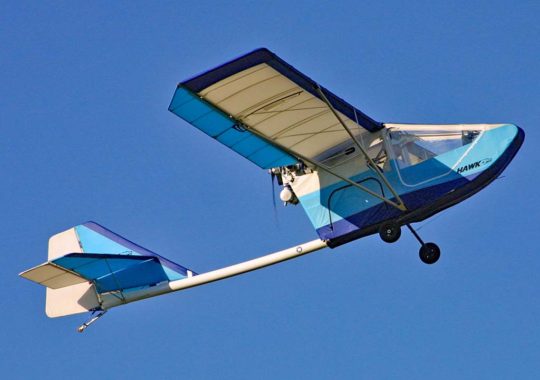
That “CGS” abbreviation usually put before Hawk was from Chuck’s even-earlier business: Chuck’s Glider Supplies. He once made hang gliders, lots of them, and that’s where Chuck and I first met. Gosh, we were young and handsome in those days. We were also stronger. I would actually attempt athletic feats like running a hang glider off a mountain cliff or stumbling my way into the air grasping my Quicksilver (which, for the record, also started off as an unpowered glider).
CGS Hawk in 2020
The video below and the text that follows are part of The Ultralight Flyer (TUF) project I have called “Ultralight April 2020.” I urge you to visit Videoman Dave‘s popular YouTube channel and to support his work. Even though we work together, I also paid real cash to be a Lifetime member: $49.95… as good a bargain as you’ll find.
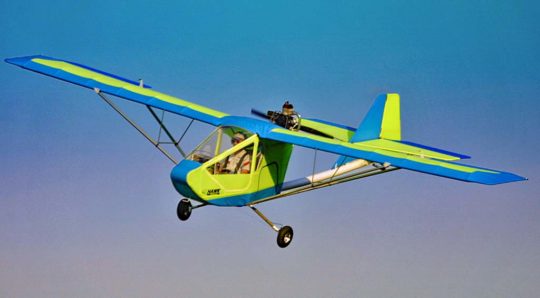
Over 40 years have passed with many Hawk aircraft still safely flying today. Some are offered for sale on various outlets. Both Dave and I have flown CGS Hawks — go here to see a long list of my Hawk reviews …I believe for every model Chuck ever made.
My words and Dave’s videos give recommendations for aircraft that we have flown, owned, and/or built. As Dave notes, all of the aircraft featured in his series still have manufacturers producing parts for their repair and continued airworthiness!
In the video below Videoman Dave gives you a quick look at the ground-breaking (for its day) aircraft. Chuck Slusarcyk introduced his proud creation at Sun ‘n Fun 1982.
After conducting a survey at a previous show, Chuck learned that pilots were looking for an affordable, enclosed, strut-braced, three-axis-control ultralight with flaps tricycle gear, and a steerable nosewheel (such was not common in those days). Like most ultralights of the time, Hawk was a pusher configuration.
A Hawk kit is available brand new in either tricycle gear or taildragger. Using bolt-and-rivet aluminum-tube construction Hawk is built around a uniquely curved main boom tube. Everyone asked about the boom and Chuck had a ready answer: “It’s a 52-foot radius curve.” In those days, such construction was quite unusual.
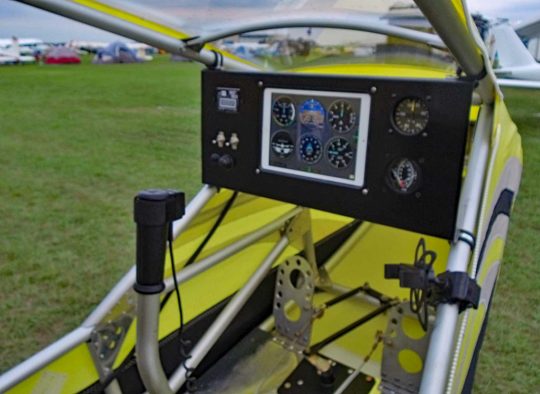
Above images courtesy The Ultralight Flyer.
An original Hawk kit took between 350 and 400 hours to build. It can be built in as little as a single car garage, using common hand tools. A small air compressor and rivet gun will save your gripping muscles. Once the airframe and wings are completed they are covered in sewn envelopes of Dacron sail cloth.
Hawk features zippered doors that can be removed. The design features standard stick and rudder controls, with a flap handle located just above and to the left of the pilot’s head.
Power was originally supplied by the Cuyuna 430 engine but later models used the Rotax 377, and 447 engines. Current ultralight models often use a single-cylinder Hirth (video review) engine.
Cruise is typically around 55 miles per hour. It has an honest climb rate of between 600 and 750 feet per minute, and stall with flaps can be as low as 22 miles per hour.
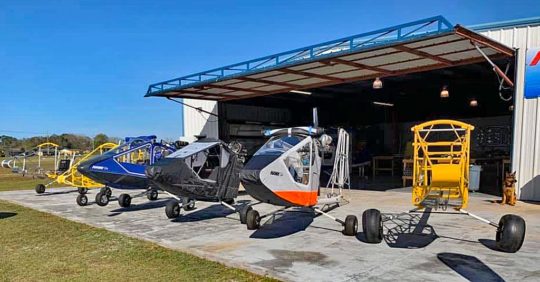
Today, CGS Aviation is located in Florida and still building these popular aircraft. More than 2,500 are flying.
A number of float systems can be retrofitted to the Hawk, as can snow skiis. Other options include a ballistic parachute system, and an in-cabin heater.
IMPORTANT: If you consider purchasing a used CGS Hawk, The Ultralight Flyer recommends that the plane’s fabric be tested and the airframe, wings, landing gear, and the control systems be thoroughly inspected!
If the history of the engine is unknown it is recommended that the exhaust be removed and the pistons inspected for wear and seizure!
At the time of production of this video The Ultralight Flyer estimates the value of a used CGS Hawk from the 1980s to be worth between $3,500 and $5,500. The Ultralight Flyer also recommends that the buyer contact CGS Aviation to inquire about any modifications or updates that the factory might recommend.


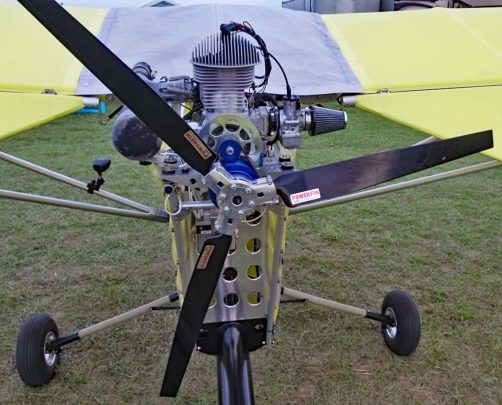
[Computer translation: Hello, I have a HAWK, Arrow single seater, lined in red
You would need the HAWK STICKER, for the sides of the cabin and in the tail
There is some possibility that they can send them to me, paying them, as they want
Thanks a lot]
Hola, tengo un HAWK, monoplaza Arrow, entelado en rojo
Necesitaria la PEGATINA DE HAWK, para los laterales de la cabina y en la cola
Hay alguna posibilidad de que me las puedan mandar, abonandolas, como quieran
Muchas gracias
Answer: Please use links in the article to contact the company directly.
[Traducción por computadora] Respuesta: Utilice los enlaces del artículo para ponerse en contacto directamente con la empresa.
I hold a private ASEL from 1965; age now 76 and can no longer pass 3rd class medical due to serious medical issues. I have never flown nor sat in a LSA. I have been spending hours in front of my computer studying the available information. Even so, unless I have overlooked vital information I am very interested in purchasing the CGS Hawk Arrow II ELSA. I will be contacting the sales force next week. I am likewise interested in the availability of this plane in a used, not-abused condition. I would greatly appreciate comments. Thanks to all. Regards,
Help. I need someone who makes the sails for the Arrow II. Tore a hole in right wing tip and need to discuss how to repair other than CGS Aviation.
TY
Fro
I don’t know why you want a supplier other than CGS Aviation, but have you tried the newest representative of this popular airplane? I urge you to contact Joseph Shirley at CGS Aviation and ask him first. Some other sewing shops may be able to do the work but I would certainly start with the one that’s already doing it.
I may be purchasing the Arrow II but I heard they use aluminum rivets would that cause the structural tube failure noted in the comments?
Also how does the Kolb Mark III compare.
Thanks, Mac
Hawk Arrow II and Kolb Mk III are significantly different (tricycle gear versus taildragger, plus other differences). I urge you to read what you find on this website (use the Search bar at the top). For the technical question, please contact CGS Aviation.
Hi Dan, just an FYI for you. The lead photo of the Red Hawk Arrow is me at Oshkosh somewhere between 2007 and 2010. I built it from a kit. When I flew it to Oskosh Airventure, Chuck complimented me on the covering job then asked to have me park it in front of his booth. He then gave me a full week pass to Airventure. I had packed a tent etc. in the storage area behind the seat and camped in the Ultralight area for a few days. What a fun time. Thanks for the great article! Dave
Wonderful information, thanks a lot for sharing kind of content with us. Your blog gives the best and the most interesting information. I wonder if we can gather such practical information about the second offering in the Ultralight April 2020 vintage series: CGS Hawk. Great one!!
While I again think you for your kind words of support, I’m not sure what you may be asking. Contact info and details were presented in the article you referenced on the CGS Hawk, plus if you search “Hawk” on ByDanJohnson.com, you will find many more articles and videos. For even more, you will need to seek out the builder. Links were provided in the article.
Mark
Chuck also told me the curve added strength.
I used to own the Company and sold it to Terry in S Lakeland.
The cage also saved many pilots from injury working as a wedge to separate tree limbs and barbed wire vs the quicksilver which did not.
2 strokes and bad gas caused a lot of problems in the early days
Plus no license no training and no brains with many owners.
But Ive heard many stories about the cage saving guys from injury from the owners themselves. FYI. HAWK HAS NEVER HAD A STRUCTURAL FAILURE
CHUCK BUILT THEM TUFF.
Sorry, Hawk HAS had structural failures. I know where one is sitting right now with a boom tube failure….like the one that caused a fatal crash, and there is also a safety bulletin about the tubes failing.
Also an elevator control failure advisory.
The truth hurts.
In the pursuit of full disclosure, I am allowing this comment BUT I do not have any verification of these statements. —DJ
In the picture of the Hawk factory where six Hawks are lined up outside, I’m proud and excited to say that mine is the yellow one, second from the left. It’s being built as an SLSA with a Rotax 912UL. Looking forward to its completion!
I am interested in the same would love to talk about it with you. Sincerely…
Thank you again for a great piece. I had a couple of questions about the boom tube, would it be a section of a circle with a diameter of 104 feet? Was it curved to make it stronger or for ground clearance? It reminds me of a hockey skate blade, which is also a section of a circle, the diameter of which will vary depending on the position played, defense vs. offense, so I am told. Thanks again, Mark Connolly.
Hi Mark: As to the precise dimensional information, all I know is the 52-foot radius comment I got from Chuck Slusarczyk. However, yes, it was done to bring the tail up to the correct position behind a pusher prop. The same goal might have reached using an angled boom tube but Chuck thought this looked better. Most agree.
Thank you.
Love this! Thanks!!
Hope to have a CGS very soon.